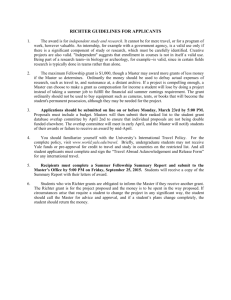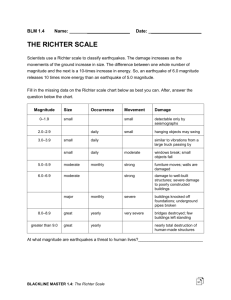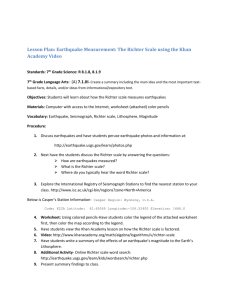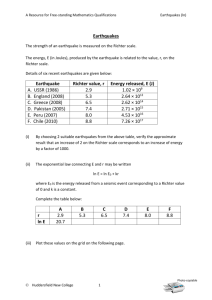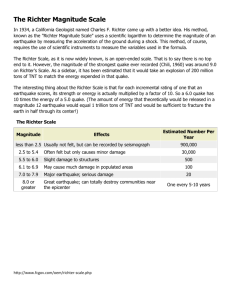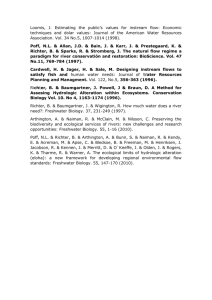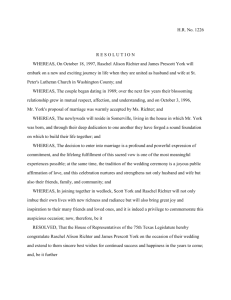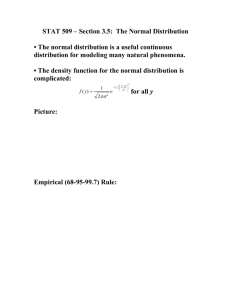Department of Aviation - Central Washington University
advertisement
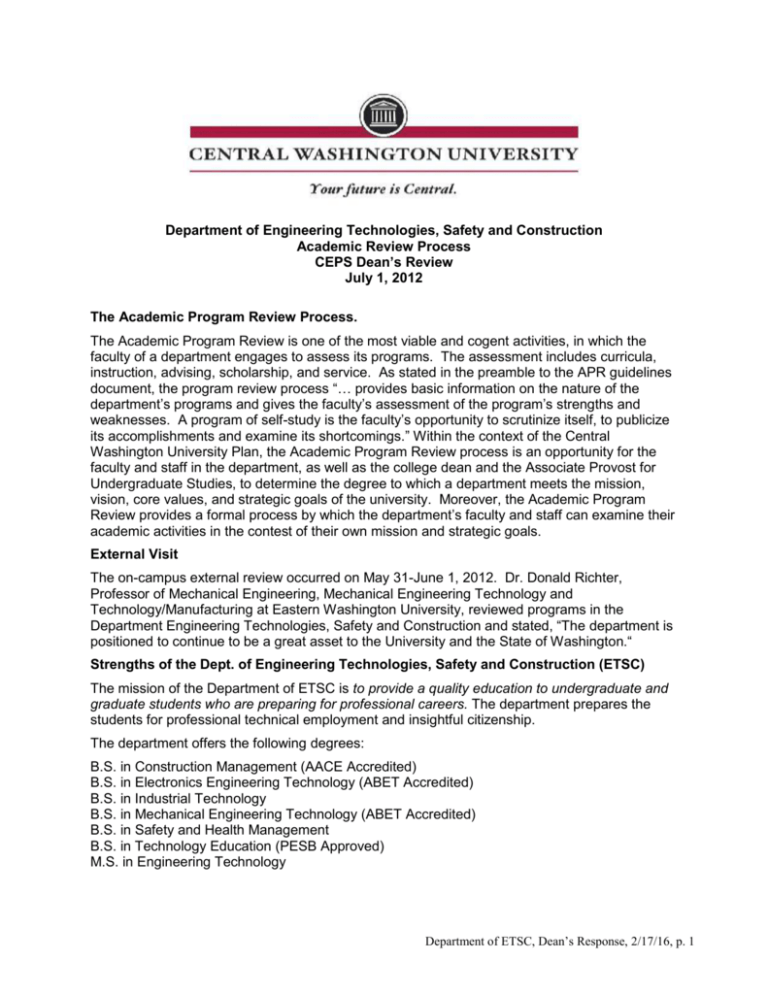
Department of Engineering Technologies, Safety and Construction Academic Review Process CEPS Dean’s Review July 1, 2012 The Academic Program Review Process. The Academic Program Review is one of the most viable and cogent activities, in which the faculty of a department engages to assess its programs. The assessment includes curricula, instruction, advising, scholarship, and service. As stated in the preamble to the APR guidelines document, the program review process “… provides basic information on the nature of the department’s programs and gives the faculty’s assessment of the program’s strengths and weaknesses. A program of self-study is the faculty’s opportunity to scrutinize itself, to publicize its accomplishments and examine its shortcomings.” Within the context of the Central Washington University Plan, the Academic Program Review process is an opportunity for the faculty and staff in the department, as well as the college dean and the Associate Provost for Undergraduate Studies, to determine the degree to which a department meets the mission, vision, core values, and strategic goals of the university. Moreover, the Academic Program Review provides a formal process by which the department’s faculty and staff can examine their academic activities in the contest of their own mission and strategic goals. External Visit The on-campus external review occurred on May 31-June 1, 2012. Dr. Donald Richter, Professor of Mechanical Engineering, Mechanical Engineering Technology and Technology/Manufacturing at Eastern Washington University, reviewed programs in the Department Engineering Technologies, Safety and Construction and stated, “The department is positioned to continue to be a great asset to the University and the State of Washington.“ Strengths of the Dept. of Engineering Technologies, Safety and Construction (ETSC) The mission of the Department of ETSC is to provide a quality education to undergraduate and graduate students who are preparing for professional careers. The department prepares the students for professional technical employment and insightful citizenship. The department offers the following degrees: B.S. in Construction Management (AACE Accredited) B.S. in Electronics Engineering Technology (ABET Accredited) B.S. in Industrial Technology B.S. in Mechanical Engineering Technology (ABET Accredited) B.S. in Safety and Health Management B.S. in Technology Education (PESB Approved) M.S. in Engineering Technology Department of ETSC, Dean’s Response, 2/17/16, p. 1 Dr. Richter identified the following strengths: Faculty. There are fourteen full-time tenured or tenure-track faculty, two fulltime instructional and classroom support technicians and one full-time clerical support person. Each tenured/tenure track faculty member has a high level of expertise, credentials and experience in his/her fields with appropriate academic and industry credentials and extensive experience in various aspects of engineering technologies, safety, or construction. Dr. Richter notes that the faulty and staff are committed and invested in student success. Additionally, Dr. Richter stated that the university and department have shown a strong commitment to faculty development through the availability of professional development funding to support scholarly activities (e.g., delivering conference presentations, publishing research). Student evaluations of instruction are used to support faculty effectiveness. Dr. Richter cautions using SEOI information as the sole measure of faculty effectiveness and supports conducing peer evaluations at regular intervals. In addition to SEOI data and peer observations, department faculty members also complete individual faculty continuous quality improvement plans and self-reflection statements. Facilities. The new Hogue and remodeling of old Hogue demonstrate the university’s commitment to the ETSC programs. Laboratory spaces and equipment provide students with current, hands-on experiences. Program Quality. ETSC has eight well-delineated goals that provide the framework for the department. One of the goals is to maintain accreditation/program approval for four programs and obtain accreditation for the Safety and Health Management program through the ABET. Dr. Richter noted the importance of program accreditation as a means of student success in competing for industry jobs. Between providing accredited programs and the new teaching and learning spaces, students in all ETSC programs gain exposure to needed experiences. Another goal focuses on building mutually beneficial partnerships with industry and professional groups. Many of the programs have advisory committees to help build or maintain industry relationships and ensure curricula remains current. Members of the committees include CWU faculty, alumnae and members of industry. Additionally, departmental programs are important for preparing for industry positions in the state. The department has the only Technology Education program in Washington State that prepares future teachers to enter STEM fields. Another goal focuses on serving the educational needs of place-bound students. The B. S. in Electrical Engineering Technology and other Industrial Technology degrees are offered at selected CWU centers through face-to-face delivery. Department programs are moving toward on-line delivery of courses that are appropriate for this delivery system and currently have three courses offered on-line during summer session. Faculty members plan to continue expanding on-line courses offering, as appropriate opportunities arise. A final example focuses on continuously improving cultural, education, and lifelong learning opportunities for students, faculty, and staff. Dr. Richter stated that faculty members are good examples for students as they maintain memberships in professional societies, attend professional conferences, focus on ethics in classes and through student clubs, and reinforce the important facets of becoming a professional. Dr. Richter also commented on the diversity of programs offered in the department and that students learn to respect other disciplines and job functions by observing how various programs interact. Department of ETSC, Dean’s Response, 2/17/16, p. 2 Students. Faculty members are meeting the professional and education needs of students. They also contribute to the general education curriculum through offering four to five sections of IET 101: Modern Technology each year that serve approximately 200 students. Several students participate in student clubs and on department-sponsored teams that compete in regional and national annual competitions. The student teams have fared very well at these competitions. Student clubs are supported with office space and Dr. Richter stated that this support demonstrates how important the department views student participation in clubs. Reported Challenges and Recommendations for the Department of Engineering Technologies, Safety and Construction (ETSC) Faculty/Staff. Dr. Richter recommends developing a plan for when an increase in department faculty members is needed. He recommends developing a five-year projection of student enrollments and then identifying when resources will be required to meet student demands. Additionally, he recommends that the plan be vetted through program stakeholders, such as the program advisory boards and industry employers. Through his interviews with students, Dr. Richter concluded that a few faculty members needed to improve their teaching skills in order to increase their teaching effectiveness. Although the department has a mentoring program for new faculty, he recommends new resources be allocated for faculty to participate in a program to improve their teaching techniques. As an example, he identified the ExCEEd program (Excellence in Civil Engineering Education offered through The American Society of Civil Engineers) that strives to improve teaching effectiveness of engineering professors. The weeklong workshop costs $425 for registration, plus additional funding for per diem. Additionally, some students did not feel that all faculty members were effective as advisors. Therefore, Dr. Richter recommends that faculty attend periodic trainings on advising issues to ensure they are fully up-to-date on the latest changes to the university’s graduation requirements. Facilities. Challenges include additional laboratory spaces and equipment. With laboratories spread over two building, the ability for instructional and classroom support technicians to staff the labs is critical. Dr. Richter recommends developing a plan that will provide adequate resources needed to staff labs during non-formal lab hours. He adds that students need reasonable access to lab equipment to produce meaningful projects. The plan needs to identify resources needed adequately staff and monitor labs to ensure student safety. Dr. Richter noted that equipment in some labs seem to be placed too close together. He recommended a safety and effectiveness study be conducted to ensure student safety and teaching effectiveness Equipment. Dr. Richter recommended developing an equipment replacement and repair plan to ensure equipment is kept current and in good working order. Budget. Although Dr. Richter did not comment on the budget, I know there has been a deep disinvestment in higher education at the state level. ETSC has stretched current resources to a great extent. Funding for paper, phones, the copier, and other office necessities is currently paid from the department self-support funds (summer net revenue or profit earned by offering income producing educational services). Additional resources are needed for faculty, staff, and reinstating goods and services. Additional funding may come from higher allocations, restored goods and services or added faculty and staff lines. Department of ETSC, Dean’s Response, 2/17/16, p. 3 Moving Forward. Dr. Richter recognizes that ETSC faculty members are committed to the students, their fields of expertise, and to the university. The department has an excellent reputation both on campus and externally. The challenges and recommendations are, therefore, to be used to enhance the department and the university. They are intended to guide faculty in maintaining high quality programs, enhancing scholarship, and generating a work-place environment conducive to optimal functioning. In summary, Dr. Richter identified three challenges currently faced by the department: 1. Student Safety: New equipment and technology has increased demands on support staff that may limit their availability to adequately oversee department laboratories. Additionally new laboratory spaces have opened and appear to have equipment spaced too close together. Department faculty will develop a plan in order to provide adequate resources needed to staff labs during non-formal lab hours. The plan could recommend additional instructional and classroom technicians to ensure student safety. The department will contact CWU safety professionals to conduct a comprehensive safety review of these new labs. 2. Additional faculty and staff. Current full time faculty members are augmented with quarter-by-quarter lecturers and graduate assistantships. For program expansion more full time faculty are needed to provide consistency in courses and service within programs. Additional faculty would be required to develop a renewable energy program or expand programs at the centers. The newly expanded building space and equipment has put a strain on the existing staff members. One additional lab technician and at least one part time office staff person will help offer faculty and students a greater level of service. Department faculty will develop a plan for when, based on student demand, an increase in department faculty members is needed and, when appropriate, submit a request to the Dean for additional faculty lines. They will conduct a needs assessment pertaining to department staffing. 3. Faculty Professional Development. Department faculty will investigate professional development opportunities for faculty to increase effectiveness in teaching. Additionally, they will check on the availability of advisors from the CWU Advising Center to provide a seminar for department faculty members on advising. The challenges identified above involve additional resources – for additional faculty and staff as well as professional development opportunities. I would be remiss if I didn’t mention the need for ETSC (and other departments in the College of Education and Professional Studies) to have funding for goods and services reinstated to 2010 levels of support. All departments are currently using summer net revenue to pay for normal operating functions, such as phones, copying, etc. I look forward to working and collaborating with faculty, staff, students, and department chair to meet the challenges and to enhance an excellent department. Department of ETSC, Dean’s Response, 2/17/16, p. 4
